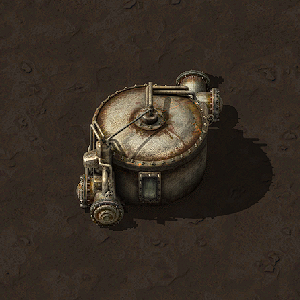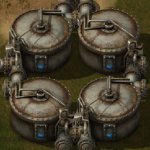Storage tank: Difference between revisions
m (change hyphen to em dash) |
SafwatHalaby (talk | contribs) (→Usage as "Energy-Tank": Moved advantages from Electric_system#Steam_tanks_as_power_storage. Removed "Electrical energy can be produced on demand, and does not have to be produced in advance and stored in accumulators." - not clear why that's "good".) |
||
| Line 17: | Line 17: | ||
A storage tank filled with [[heat exchanger]] 500°C steam stores around 2.4GJ; a storage tank filled with [[boiler]] 165°C steam stores 750MJ. | A storage tank filled with [[heat exchanger]] 500°C steam stores around 2.4GJ; a storage tank filled with [[boiler]] 165°C steam stores 750MJ. | ||
There are several advantages to storing energy in storage tanks compared with storing it in an accumulator: | |||
* The energy density of a storage tank tile is much higher than it is with accumulators. | |||
** For 165°C steam (produced with [[boiler|boilers]]), a single storage tank stores as much as 15 accumulators: <code>750MJ / 5MJ = 150</code> | |||
** For 500°C steam (produced using [[Heat exchanger|heat exchangers]]), a single storage tank stores as much as 48 accumulators: <code>2400MJ / 5MJ = 480</code> | |||
* A [[nuclear reactor]] always fully burns a fuel cell, releasing 8GJ (or more with the multiple reactor bonus) even if power demand is lower. The excess energy can be stored as steam. | |||
* A single [[accumulator]]'s maximum discharge rate is 300kW. On a very heavy load (e.g.), an accumulator array may not discharge fast enough. A steam engine can produce 900kW of energy from the stored steam (3 times faster discharge rate), and a turbine can produce 5800kW (6.4 times faster discharge rate). In other words, a number of turbines or steam engines with steam storage can cope with much higher bursts than the same number of accumulators. | |||
* Steam can be transferred via trains and then consumed remotely via turbines or steam engines. This essentially "transports electricity" using trains. | |||
* 1 '''Storage tank''' can store 25,000 units of 500ºC steam. | * 1 '''Storage tank''' can store 25,000 units of 500ºC steam. | ||
Revision as of 16:11, 13 May 2018
| Storage tank |
The storage tank is a building that can store up to 25,000 units of a fluid. It is a passive storage—it has no input and no output, depending on pressure to fill it, essentially being a large pipe.
Usage
Storage tanks will only be filled to the same percentage of capacity as pipes that lead to it. Pipe that always carries about 50 water will fill the tank to about 50% of its capacity. Pumps can be used to fill the entire tank from a low pressure source (such as distant pumpjacks).
The storage tank is typically used to store excess oils to ensure that oil refinery works smoothly. It can also be connected to the circuit network, sending the fluid contents as a signal to the network.
The storage tank can be emptied by mining and rebuilding it (the fluid is destroyed) or by draining it with a pump.
Usage as "Energy-Tank"
Storage tanks can also be used as steam-based accumulators. If steam consumption by steam engines or turbines changes a lot over a daily cycle (for example because of solar panels or laser turrets), storage tanks can be filled with steam during low power usage and then emptied during heavy load.
A storage tank filled with heat exchanger 500°C steam stores around 2.4GJ; a storage tank filled with boiler 165°C steam stores 750MJ.
There are several advantages to storing energy in storage tanks compared with storing it in an accumulator:
- The energy density of a storage tank tile is much higher than it is with accumulators.
- For 165°C steam (produced with boilers), a single storage tank stores as much as 15 accumulators:
750MJ / 5MJ = 150 - For 500°C steam (produced using heat exchangers), a single storage tank stores as much as 48 accumulators:
2400MJ / 5MJ = 480
- For 165°C steam (produced with boilers), a single storage tank stores as much as 15 accumulators:
- A nuclear reactor always fully burns a fuel cell, releasing 8GJ (or more with the multiple reactor bonus) even if power demand is lower. The excess energy can be stored as steam.
- A single accumulator's maximum discharge rate is 300kW. On a very heavy load (e.g.), an accumulator array may not discharge fast enough. A steam engine can produce 900kW of energy from the stored steam (3 times faster discharge rate), and a turbine can produce 5800kW (6.4 times faster discharge rate). In other words, a number of turbines or steam engines with steam storage can cope with much higher bursts than the same number of accumulators.
- Steam can be transferred via trains and then consumed remotely via turbines or steam engines. This essentially "transports electricity" using trains.
- 1 Storage tank can store 25,000 units of 500ºC steam.
- 1 Steam turbine can output 5,820kW = 5,820kJ/s using 60 units of 500ºC steam/s.
- 1 Storage tank can keep 1 steam turbine working for 25,000 ∕ 60 ≈ 416.6667s
- A Storage tank can store up to 25,000 ∕ 60 × 5,820 = 2,425,000kJ using 500ºC steam.
- 1 Storage tank can store 25,000 units of 165ºC steam.
- 1 Steam engine can output 900kW = 900kJ/s using 30 units of 165ºC steam/s.
- 1 Storage tank can keep 1 steam engine working for 25,000 ∕ 30 ≈ 833.3333s
- A Storage tank can store up to 25,000 ∕ 30 × 900 = 750,000kJ using 165ºC steam.
History
- 0.15.0:
- Multiplied all fluid amounts by 10.
- 0.13.12:
- Fluid icon now scales with size of tank.
- 0.12.0:
- Liquid inside can be seen through a small window.
- Now connectible to the circuit network.
- 0.9.1:
- Now has double capacity and takes longer to mine.
- 0.9.0:
- Introduced

